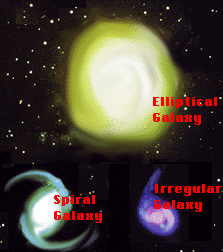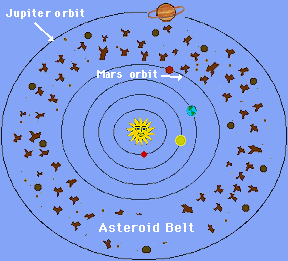| Galaxies |

A light-year is the distance light travels in one year. It is 9.5 trillion (9,500,000,000,000) kilometers. The size of a galaxy may be as little as a thousand light-years across or as much as a million light-years across. A galaxy contains stars, gas, and dust which are held together as a group by gravity. There may be millions, or even billions, of stars in one galaxy. There are billions of galaxies in the Universe. Galaxies are labeled according to their shape. Some galaxies are called "spiral", because they look like giant pinwheels in the sky. The galaxy we live in, the Milky Way, is a spiral galaxy. Some galaxies are called "elliptical", because they look like flat balls. A galaxy may be called "irregular" if it doesn't really have a shape. A new type of galaxy was discovered recently, called a "starburst" galaxy. In this type of galaxy, new stars just seem to 'burst out' very quickly.
| The Milky Way |
There are over 100 billion stars in the Milky Way galaxy. If you tried to count them one by one, it would take you over 3000 years! The Milky Way is over 100,000 light-years wide. It is called a spiral galaxy because it has long arms which spin around like a giant pinwheel. Our Sun is a star in one of the arms. When you look up at the night sky, most of the stars you see are in one of the Milky Way arms. Before we had telescopes, people could not see many of the stars very clearly. They blurred together in a white streak across the sky. A myth by the ancient Greeks said this white streak was a "river of milk". The ancient Romans called it the Via Galactica, or "road made of milk". This is how our galaxy became known as the Milky Way.
| The Asteroid Belt |

So far, the largest asteroid found in the asteroid belt is as big as the state of Texas. It has been named Ceres. An asteroid is a bit of rock. It can be thought of as what was "left over" after the Sun and all the planets were formed. Most of the asteroids in our solar system can be found orbiting the Sun between the orbits of Mars and Jupiter. This area is sometimes called the "asteroid belt". Think about it this way: the asteroid belt is a big highway in a circle around the Sun. Think about the asteroids as cars on the highway. Sometimes, the asteroid cars run into one another. When this happens, the asteroids may break up into smaller asteroids. Scientists think that most asteroids are the result of collisions between larger rocky space bodies. Asteroids can be a few feet to several hundred miles wide. The belt probably contains at least 40,000 asteroids that are more than 0.5 miles across. If an asteroid is captured by the gravitational pull of a planet, the asteroid can be pulled out of the belt and go into orbit as a moon around the planet that pulled on it.
| Planets |
A planet is a large space object which revolves around a star. It also reflects that star's light. Nine planets have been discovered in our solar system. Mercury, Venus, Earth, and Mars are the planets closest to the Sun. They are called the inner planets. The inner planets are made up mostly of rock. The outer planets are Jupiter, Saturn, Uranus, Neptune, and Pluto. Jupiter, Saturn, Uranus, and Neptune are large balls of gases with rings around them. Pluto is the farthest planet from the Sun. It is coated with ice. All nine planets travel around the Sun in a different orbit.
The Inner Planets The Outer Planets Mercury Jupiter Venus Saturn Earth Uranus Mars Neptune Pluto
Home About us Our school Links to our favorites Vikings Have fun
Read My Guestbook! | Sign My Guestbook!
beyond2005@hotmail.com